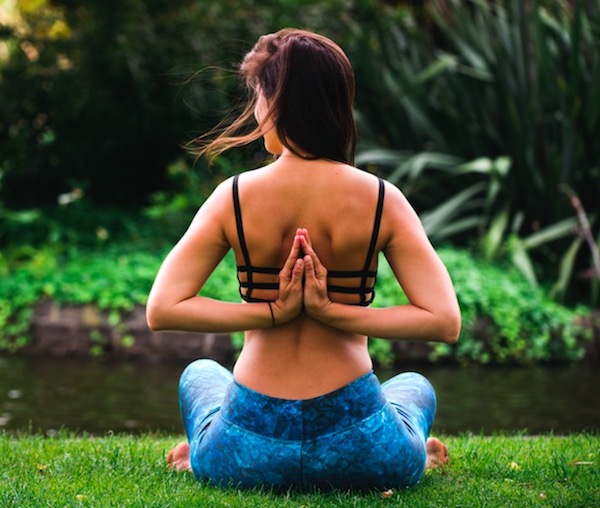
There’s a lot of buzz around the Interwebs lately about mindfulness.
We hear the word everywhere—in the workplace, the yoga studio, even on sports fields. Mindfulness seems to be some sort of magic wand that we can wave to become more productive, focused, stress-free, and relaxed. But what does a mindful life really look like?
First of all, for the uninitiated, I should explain that mindfulness is essentially the practice of bringing one’s attention to the present moment. It’s a way of freeing oneself from the exhausting experience of living in the future or the past, and applying our focus to the here and now.
I was introduced to the concept of mindfulness about six years ago by a stress therapist after having undergone a traumatic incident in my work environment. I was experiencing panic attacks and constant anxiety—basically, I was miserable. During the course of treatment I was given a toolbox of different techniques for coping with stress and anxiety, and it was one of the simplest techniques that I found to be the most effective.
At the beginning of each day, I was to mark a small dot on the back of my hand using a pen or marker. As I went about my day, every time I glanced at my hand and saw that dot I was reminded to ask myself, “Where is my mind?”
This technique, albeit simple, was (no pun intended) mind-blowing for me—it exposed my thought practices. I realized that my mind wandered away from the present moment literally hundreds, maybe even thousands, of times each day!
Since then, I have adopted mindfulness as a bit of a hobby. So, let’s break this concept down together—and explore why mindfulness is more relevant to our current lifestyles than ever before.
1. No Time Like the Present
I have a confession to make—I’m not a very good driver. I detest sitting still for more than five minutes at a time, and the constant stop-and-go of traffic drives me nuts. I don’t think I’m alone in admitting that my mind wanders a great deal more than usual while I’m driving. In fact, we’re all likely to zone out while performing actions that we repeat on a daily basis—pouring our cereal, walking to the bus stop, showering, and the list goes on. It’s rare that we sit down to a meal with the sole intention of tasting each and every mouthful of our food, chewing slowly, and then waiting for our food to digest before we speed off to the next activity.
Our society places a premium on a person’s ability to create plans for the future—whether it be five minutes, five days, or five years, we pride ourselves on our ability to multitask. However, we don’t necessarily want to be mentally furnishing our dream home before the builders have actually drawn up the plans in reality.
This is where mindfulness comes in. By training ourselves to focus on the here and now, we become more connected to our present experiences. This is a beautiful practice that allows us to draw more meaning and satisfaction from the present moment, without becoming caught up in what happened yesterday, or what might happen tomorrow.
2. Start Small
Okay, so we can probably all agree that mindfulness sounds appealing—but where to begin?
Here’s the good news: we already have all of the tools we need to get mindful. Start with your breath. Notice how your chest rises and falls as you inhale and exhale. Slowly become aware of your senses. Can you feel the air passing through your nostrils? What does your breath sound like? What does it feel like? Tune in to the sensations of your breath and your body for a total of five deep breaths. This simple awareness is a mindful breathing exercise.
Once this becomes easy, you can move on to mindful awareness of your environment. Pick a repetitive action that you perform every single day. Brushing your teeth is a great example (and I confess, yours truly has been known to write emails, wash dishes, and even perform some light stretching all while brushing my teeth!). Observe how your mind may be tempted to stray beyond the task at hand. When your mind wanders, aim to bring it back to the physical sensations you feel on your gums and teeth or the taste of your toothpaste.
Using simple exercises like these, we can train our minds to function in the present more easily.
3. Not the New Kid
Mindfulness might be new to Gen Y, but it’s actually been around for thousands of years. Ancient Buddhists valued mindfulness as one of the seven factors of enlightenment, and attributed it toward the attainment of nirvana.
The word sati, which we often translate as “mindfulness,” actually translates more closely to “memory,” and this was used to memorize Vedic scriptures. To effectively recall large bodies of text, monks would aim to enter a zone of clarity and presence, free from distraction.
4. Reap the Rewards
For something that’s so easy to cultivate, mindfulness has an impressive list of benefits. It’s like closing down all of the applications on our phones—our “batteries” last longer and we’re less likely to crash. Mindfulness can bring more sweetness to life’s lovely moments, but it can also help us to process feelings of turbulence, stress, and grief more efficiently. We become attuned to our bodies and minds, and proficient at casting aside judgement, resulting in longer periods of calm and peace during daily life.
Mindfulness can also help us to become more productive in our chosen pursuits. Whether studying for a test, practicing an instrument, or learning a language, the ability to single-mindedly focus on the present moment means we can absorb and retain more information than when we are distracted.
And, of course, mindfulness plays a key role in the development of our meditation practices. I can honestly say that I never thought I would be interested in, or capable of, meditation—it just seemed so difficult! And while I’m far from a pro at sitting with stillness, I can definitely confirm that my ability to meditate has improved by applying mindful awareness to my breath.
For me, mindfulness is a matter of “if at first you don’t succeed, try, try again.” Some days my mind feels peaceful and clear, and other days my mind behaves like a small child on her fourth cup of red cordial. Just like with my practice of yoga, I accept that I’m not going to feel balanced and steady all the time. But I know I’m better for trying. And, if all else fails, I can always get a pen out and draw a dot on the back of my hand.
~
Author: Holly Norman
Image: Ludosphère/Flickr & Author’s Own
Editor: Leah Sugerman
Ready to join?
Hey, thanks so much for reading! Elephant offers 1 article every month for free.
If you want more, grab a subscription for unlimited reads for $5/year (normally, it's $108/year, and the discount ends soon).
And clearly you appreciate mindfulness with a sense of humor and integrity! Why not join the Elephant community, become an Elephriend?
Your investment will help Elephant Journal invest in our editors and writers who promote your values to create the change you want to see in your world!
Already have an account? Log in.
Ready to join?
Hey, thanks so much for reading! Elephant offers 1 article every month for free.
If you want more, grab a subscription for unlimited reads for $5/year (normally, it's $108/year, and the discount ends soon).
And clearly you appreciate mindfulness with a sense of humor and integrity! Why not join the Elephant community, become an Elephriend?
Your investment will help Elephant Journal invest in our editors and writers who promote your values to create the change you want to see in your world!
Already have an account? Log in.
 Share on bsky
Share on bsky


Read 0 comments and reply